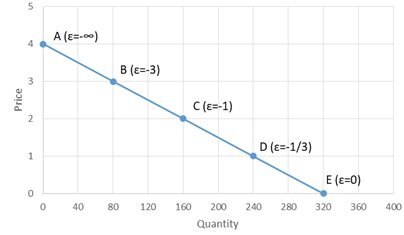
Elasticity as an economic term shows a variable’s sensitivity or responsiveness to a change in another variable. The relationship between any two variables can be shown by an elasticity. As an example; the elasticity of demand is the percentage change in quantity demanded (Q) divided by the percentage change in price (P). We can show this definition / example in a simple equation form:
Elasticity = % Change in Quantity (%ΔQ) / % Change in Price (%ΔP)
Elasticity changes along downward sloping demand curve. In below figure you can see how elasticity changes along demand curve.

Below observations can be made from above chart:
- The higher the price, the more elastic the demand curve (think it as absolute value)
- At point A elasticity is perfectly elastic (ε = – ∞) where the demand curve hits the vertical axis
- At point E elasticity is perfectly inelastic (ε = 0) where the demand curve hits the horizontal axis
- At point C, we have an elasticity of 1 (unitary elasticity)
Someone may ask what is the situation if the demand curve is not downward sloping and the answer to that question would be;
- The elasticity is perfectly elastic (ε = – ∞) at every point of horizontal demand curves (slight price increase cause demand to fall zero, examples are easily replaceable goods)
- The elasticity is perfectly inelastic (ε = 0) at every point of vertical demand curves (price increase does not cause any change in demand since those goods can be think as essential)
As a note, since it is easy to replace (substitute goods) between products in the long run compared to short run, long run elasticity is higher compared to short run elasticity.
Other important examples of elasticity are;
Income elasticity which is the percentage change in the quantity demanded divided by the percentage change in income. Normal goods have positive income elasticity such as fruits whereas inferior goods have negative income elasticity such as bread.
Cross price elasticity is the percentage change in the quantity demanded divided by the percentage change in the price of other good. Complementary goods have negative cross price elasticity (movie and popcorn) since the price of movie increases you see less movies and buy less popcorn. Substitute goods have positive cross price elasticity (tea and coffee) since the price of coffee increases, you buy less coffee and substitute it with tea and buy more tea.
Business / Government Applications of Elasticity
It is very critical for businesses to know their products price elasticity of demand since it is a very important phenomenon which directly affects their income and profitability. If a company is selling a high elasticity product (absolute value of elasticity > 1) an increase in price will result with a revenue drop and a decrease in price will result with a revenue increase. On the other hand if the elasticity is lower (<1) firm can set a higher price and enjoy the increase of its revenues and profits.
For tax applications; if the demand is inelastic (tobacco can be a good example), increase in tax will cause a small fall in demand since it is hard to quit smoking. As a result, government will see an increase in their tax revenues.
Of course the real world is much more complex than that but firms and governments are analyzing / using elasticity to increase their income / tax revenues and elasticity has a huge impact on general economy (demand side, supply side, minimum wages, tax etc.).
If you have any questions please comment below.
Thanks…
Leave a comment